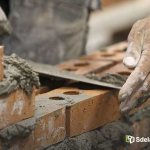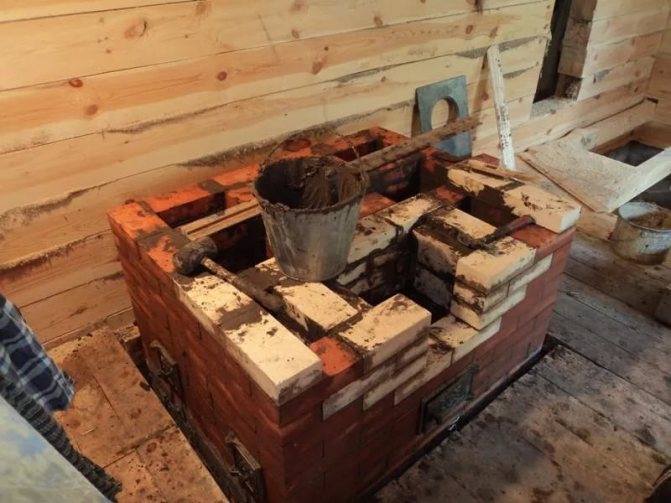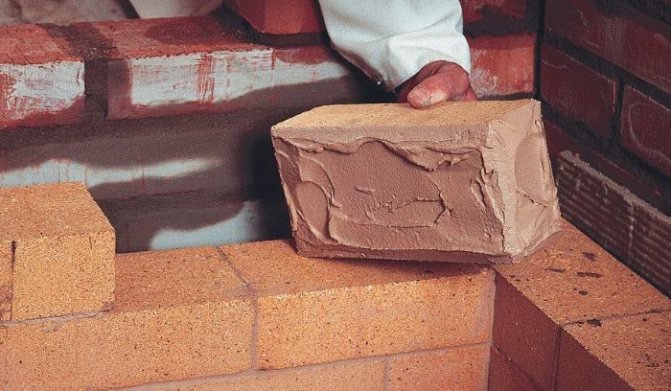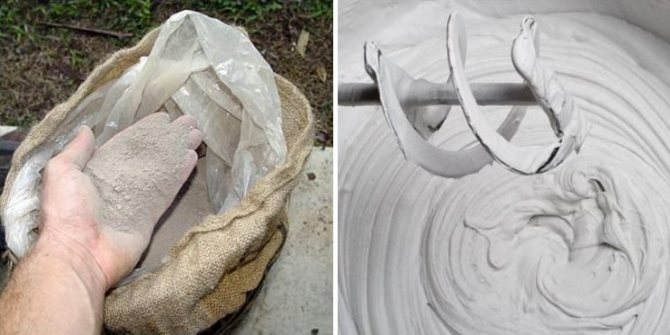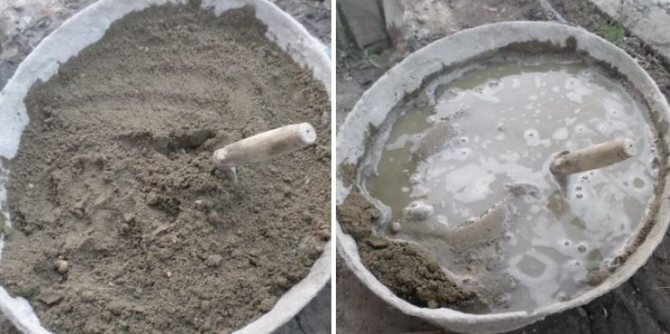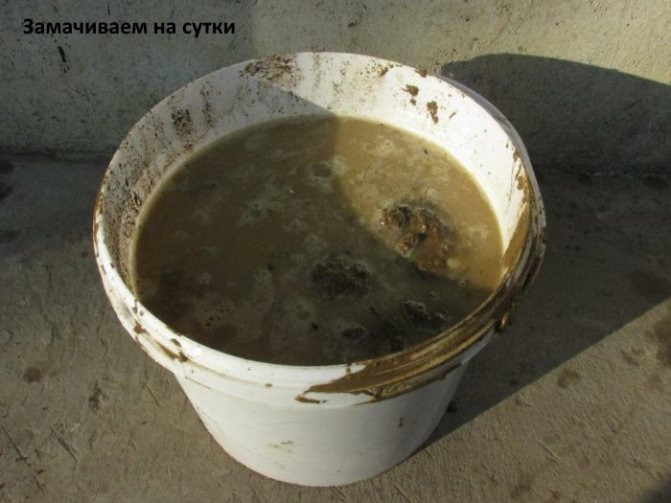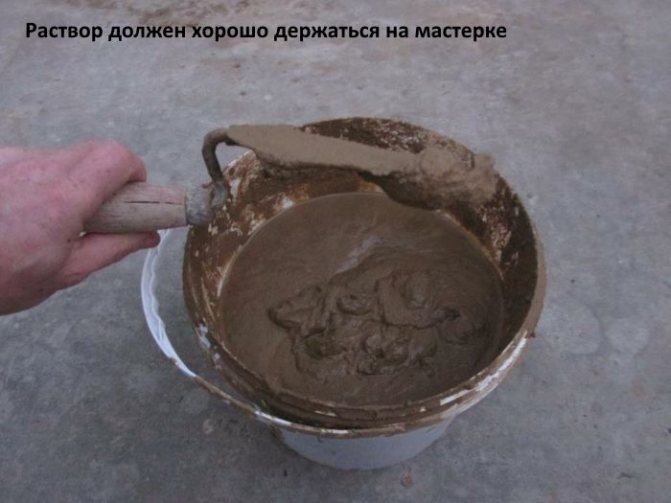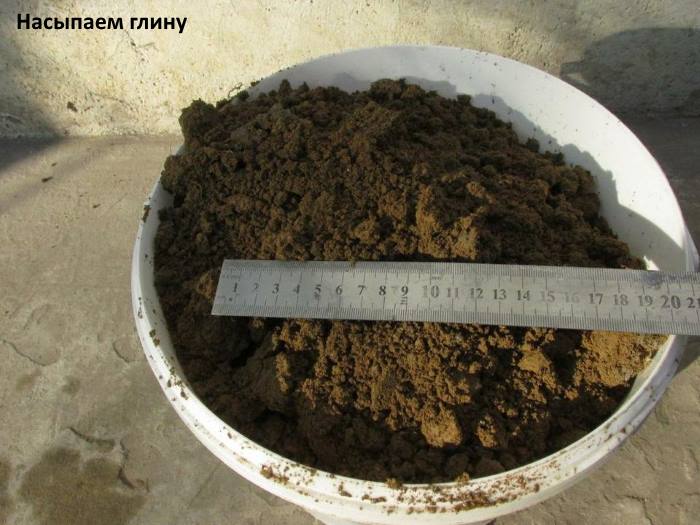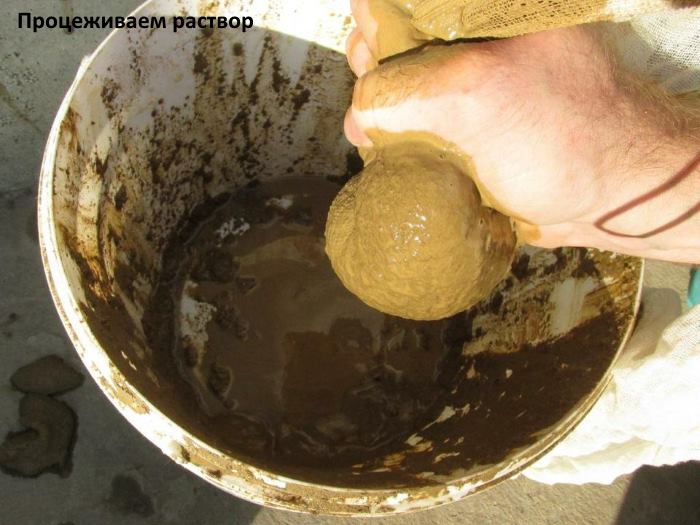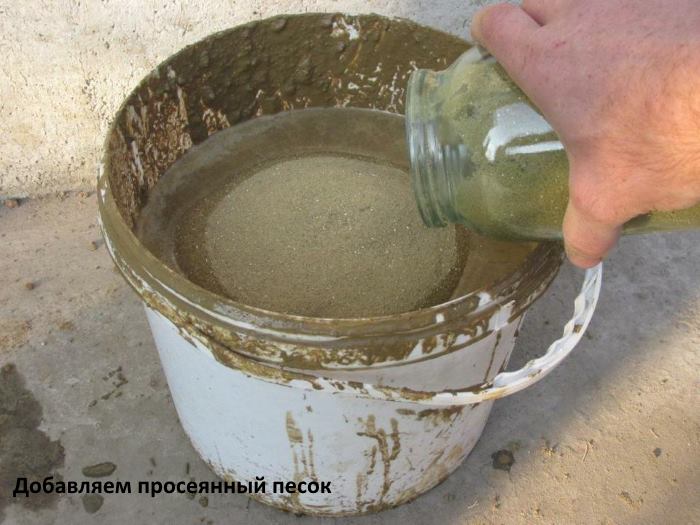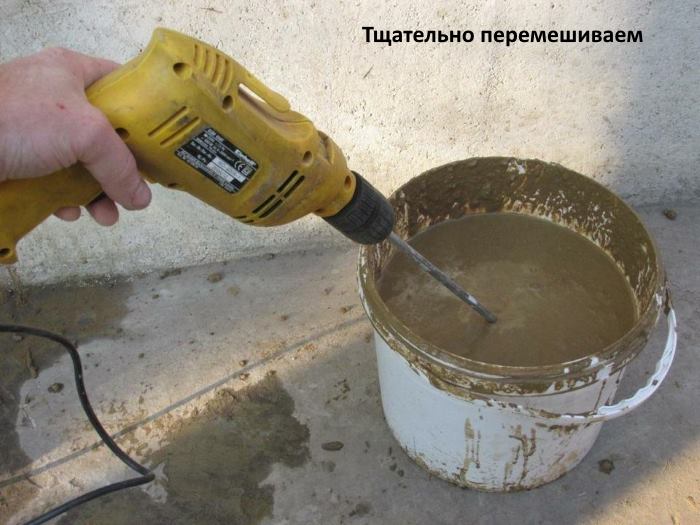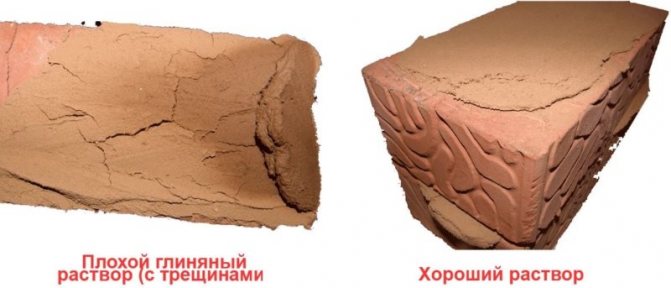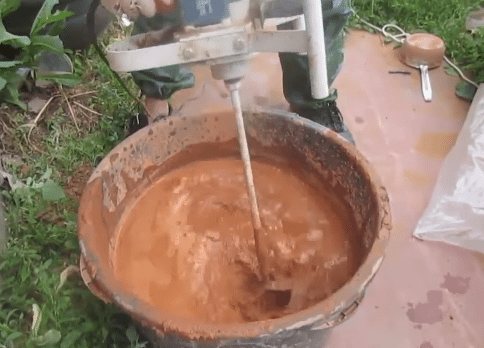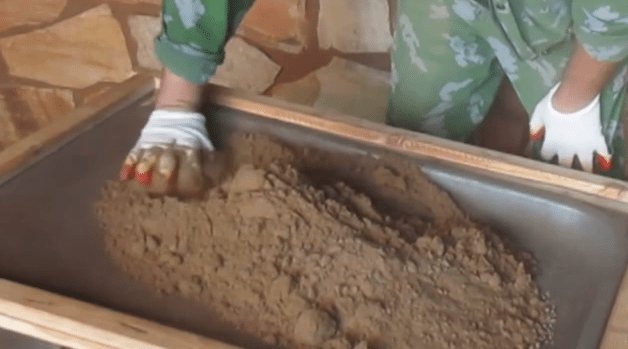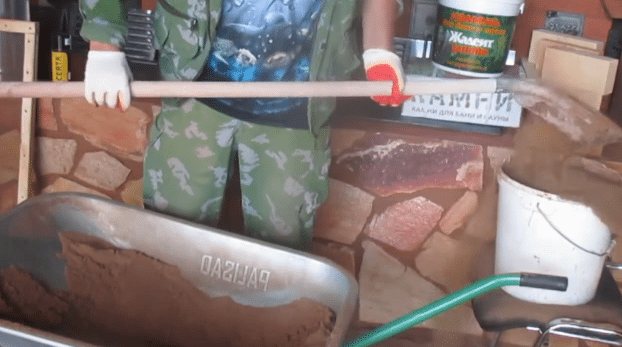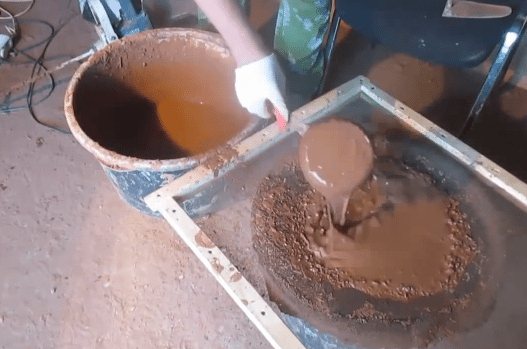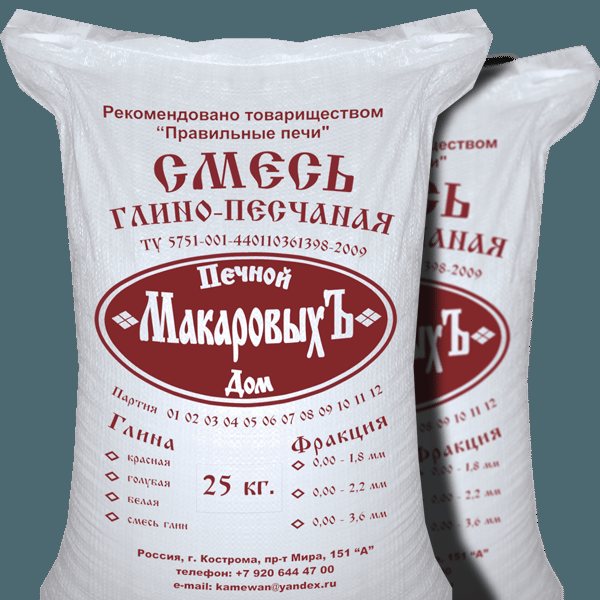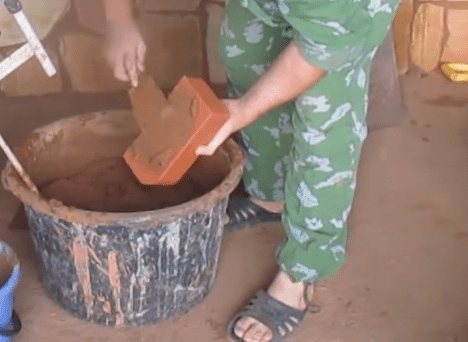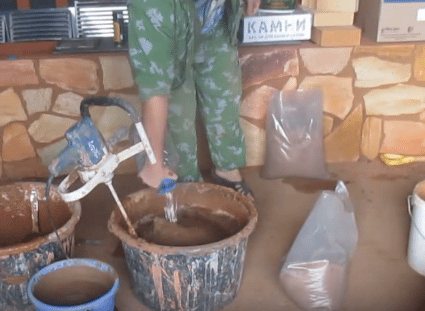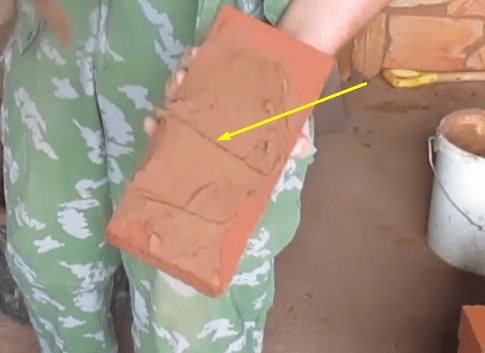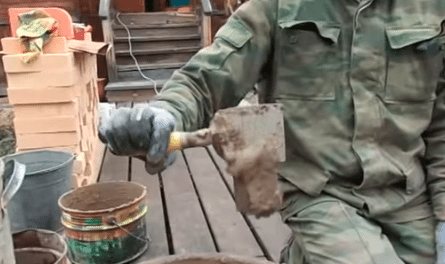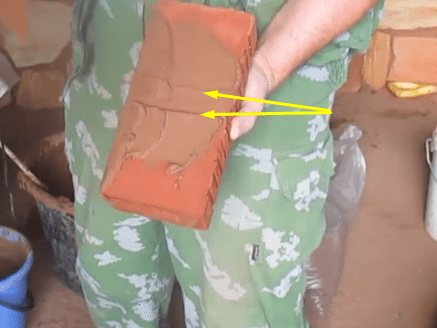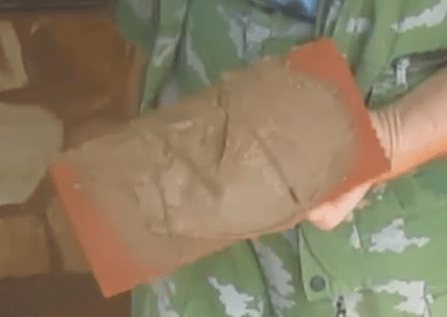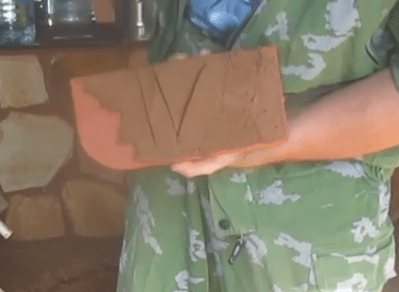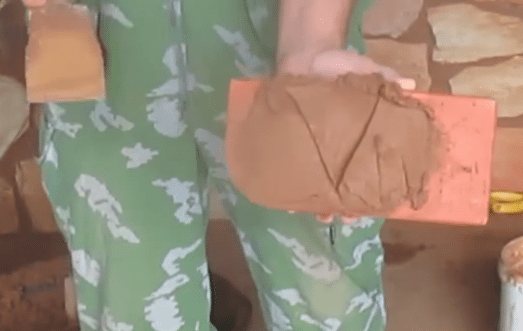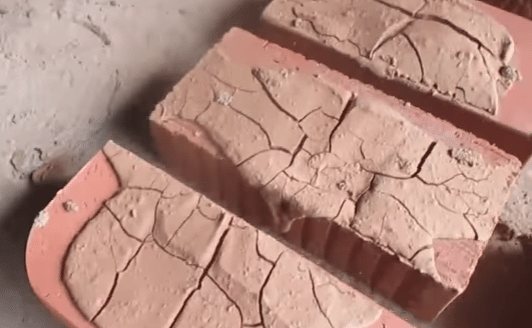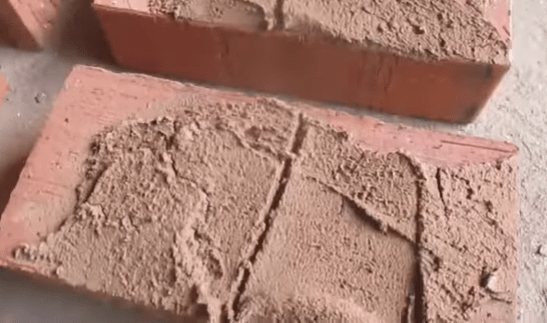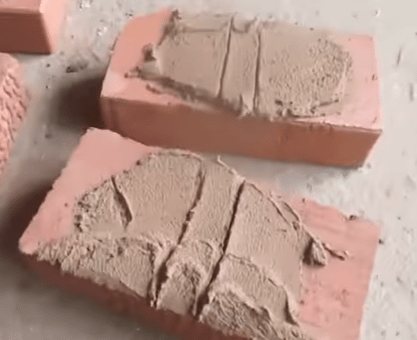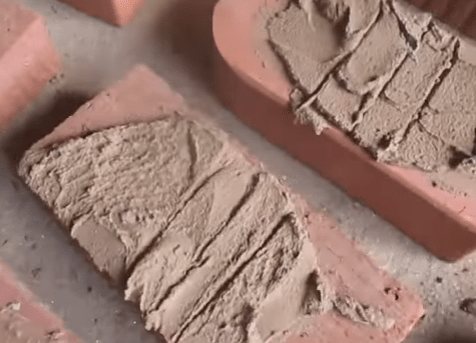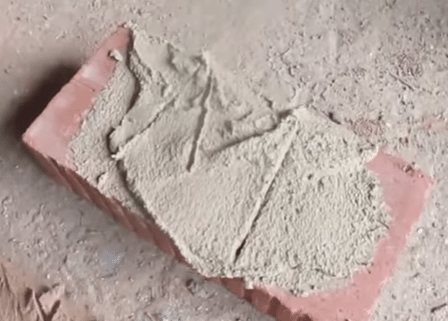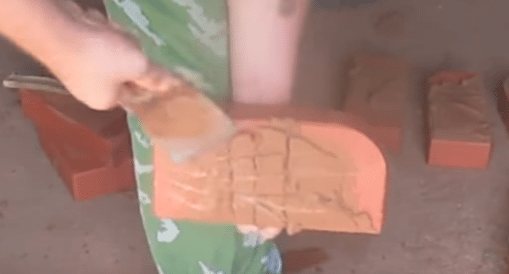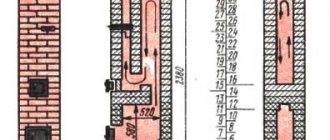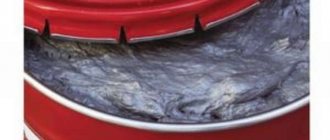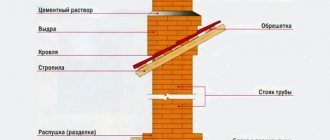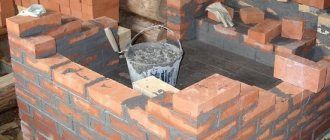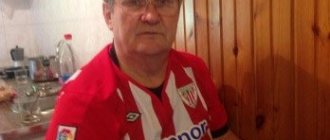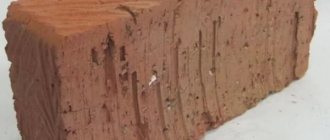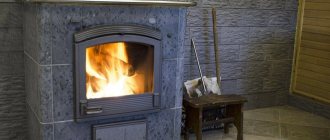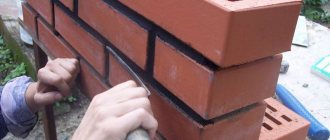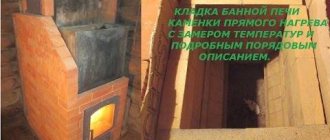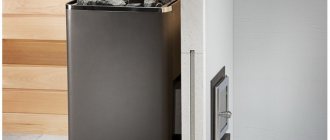Kiln clay
Clay is an irreplaceable material in the preparation of masonry mortar. It owes its demand to unique properties, which consist in the magical transformation of clay into stone after being treated with fire. During the firing process, it acquires the strength inherent in brick, gives excellent adhesion to the structure and withstands the highest temperatures. However, in order to achieve its maximum qualities, it is necessary to prepare a mortar for laying the oven with an optimal ratio of ingredients.
The autonomy and special rustic flavor of wood heating of country cottages compete with gas boilers. You can fold the oven for your home yourself with the right choice of materials. To avoid the appearance of cracks in the housing, brick and masonry mortar should react equally to mechanical and thermal loads, exposure to flue gases. The cement mixture deforms when heated and is not suitable for the construction of heat-resistant structures.
Masonry mortars for the main parts of the oven
1. The furnace part made of refractory bricks (marked with Ш) can withstand heating above 1000 C. The masonry is fastened with a heat-resistant mixture, the main component of which is fireclay clay.
2. The heat storage chamber is heated up to 600 C, the effect of flue gases and acid condensate. Ceramic bricks (solid "oven" M 150) and clay mortar are used for the walls.
3. The chimney is under its own and wind load. The outer pipe is laid out of ordinary bricks on a lime mixture.
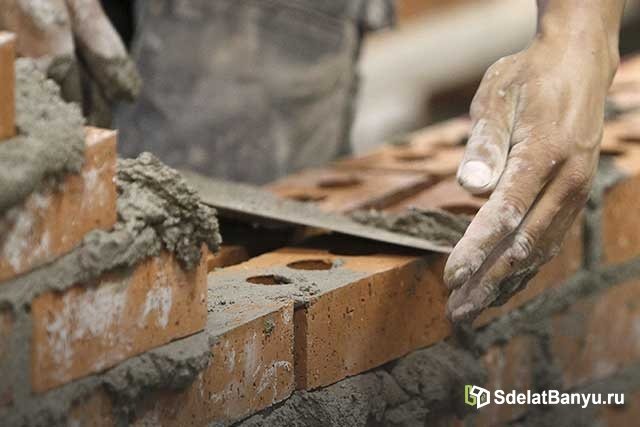
4. In case of deformation, the foundation requires disassembly of the furnace. Therefore, for the base, a strong cement-lime composition and solid brick with good bearing capacity are chosen.
Traditionally, clay mortar is used for laying stoves, since it can withstand temperatures up to 1400 C, has a maximum density, that is, it completely does not let smoke and waste into the room. The microporosity of the material allows the walls of the oven to absorb moisture vapor and "breathe". When heated, clay joints do not expand or crack when cooled. It is possible to disassemble the structure in case of repair work without deformation and waste.
Tricky electricity-saving meter Pays off in 2 months!
Clay is a common mineral on Earth. Outcrops are visible almost everywhere. Despite this, not every clay is suitable for oven work.
The complex of basic qualities is determined by fat content. Clay is oily, medium-fat and lean.
- Oily ˗ plastic, but when dry it cracks and gives strong shrinkage. This leads to deformation and destruction of the structure.
- Medium fat clay is the best option. She has good adhesive properties, strong, heat-resistant, hygroscopic. When dry, it gives a moderate sediment, does not crack.
- Skinny clay has low adhesive properties. It is dry, cracks quickly, the masonry crumbles.


Finding good clay is a great success. Good seams occur at a depth of 5 meters. The surface ones are heavily contaminated with humus, they have a high content of sand impurities. It is loamy, skinny soil. She's not good for the job.
There is a clay formation under the loam layer. The thicker the layer, the better. The lower layers are the fattest clay, but it is also not clean. It is better to take from the middle layers with the lowest content of organic matter and impurities.
Types of mixtures for laying stoves
All masonry mortars are divided into three types, which are often confused with each other:
- Heat-resistant solution - able to withstand heating to high temperatures. Upon cooling, it does not undergo structural changes, the loss of chemical properties, is not subject to irreversible deformations. Such a solution holds the static load well, even in a heated state.
- Heat resistant solution - in a heated state it retains all its mechanical properties. The thermal deformations of such a solution are much lower than that of a heat-resistant one. The solution is capable of carrying not only static, but also dynamic loads.
- Refractory mortar - can be both heat-resistant and heat-resistant. Such a solution can easily withstand very high temperatures and exposure to chemically aggressive furnace gases.
All mortars used for laying furnaces, even if these are structures that do not heat up over 400 degrees, must be refractory and heat-resistant. Conventional mortars are not suitable for oven masonry.
Attention! All the names of complex masonry mixtures begin with the strongest binder, even if there is very little of it in the composition of the solution.
Types of clay solutions for stoves and fireplaces
When laying the stove, depending on the temperature regime of the zone being built, several types of mortar are used:
- 1200-1300 С - clay-fireclay and cement-fireclay;
- 1100 С - clay-sand mixture;
- 450-500 С - lime-sand;
- 220-250 С - cement-lime;
- range of atmospheric temperatures (furnace foundation) - cement-sand mixture.
Of the listed masonry mortars, clay or chamotte made from it are included in three mixtures: clay-sand, clay-chamotte and cement-chamotte).
Consider these important components of masonry kiln mixes.
Ready-made masonry refractory mixtures for stoves and fireplaces
There is a wide variety of masonry mortars on the market, which are focused specifically on the arrangement of stoves and fireplaces.
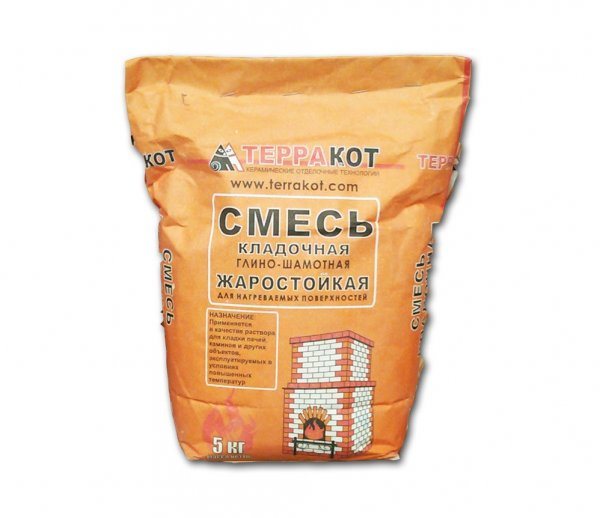

Photo 4. Ready dry heat-resistant mixture for laying stoves and fireplaces. ...
These mixtures include:
- "Terracotta", the mixture can withstand very high temperatures, up to +1300 ° C, waterproof, suitable for ceramic, fireclay bricks. Consists of a mixture of chamotte, sand, clay.
- "Pechnik", masonry mixture, withstands temperature up to +1350 ° C, consists of refractory clay, cement, mineral fillers and modifying additives.
- Furnace mixture "Kostroma" from the Makarov Stove House, used in the construction of stoves, fireplaces, barbecues. Heat resistance +750 ° C.
- Fireclay clay "Diana", heat resistance +1600 ° C, used in the construction of saunas, masonry stoves and fireplaces. It is considered an ideal solution for stove masonry in any furnace mode. Can be used for laying tiles on the stove.
Important! It is necessary to carry out masonry work indoors at a temperature from +5 ° C.
There are positive aspects in ready-made mixtures, it saves time and effort. But they also require and compliance with certain rules:
- when mixing, a mixer is used;
- do not allow the mixture to harden;
- it is possible to start operation only after a certain time.
The quality of the mixtures sold are often higher than with manual production, but they are more expensive.
Checking the quality of the solution
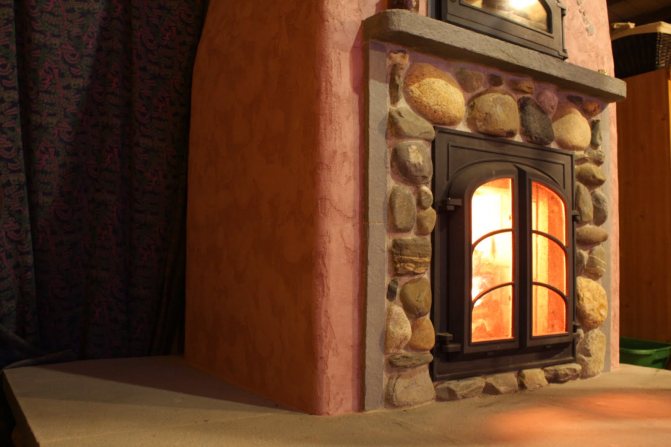

The first test is carried out before preparing the clay for the brickwork of the oven. In order for the solution to come out of high quality, you need to accurately identify the fat content of the clay. It will depend on this, what additional components are required.
How greasy oven clay is revealed as follows:
- A small amount of clay - about 1 kg - is thoroughly cleaned using one of the methods described and soaked for several days.
- The resulting mass is divided into five identical parts.Nothing is added to the first, the second is mixed with 25 percent sifted sand, the third with 50 percent, the fourth with 75 percent and the fifth with 100 percent.
- Each of the parts is kneaded separately. If necessary, add a little water until a pasty texture is achieved. You can determine the readiness of the solution with your hands. If it does not stick, the mixture is considered ready.
- The resulting material is checked for ductility. Each of the five particles is rolled into a small ball and flattened into a cake. All the resulting samples are marked with labels, which indicate the proportions of sand, and sent to dry. It will take 2-3 days for the fragments to dry.
- The resulting samples are tested. The cake should not be cracked or shattered when compressed. If you drop it on the floor, it should remain intact. Based on the results of such testing, the correct proportion of sand and clay components is revealed.
You can test for fat content and plasticity in another way. Roll into balls about 3 cm in diameter, placing each ball between two carefully rounded boards. Gently, smoothly press on the upper one, check the condition of the ball. If it cracks immediately, the composition lacks fat content. If cracks occur at half compression, the mixture is too greasy. With the correct proportion of the components, most of the specimen will flatten but not collapse.
Correctly formulated mortar does not crack immediately after application
Additionally, kiln clay is tested before use. Better to redo the mortar than waste time building a stove that will crumble. To check, the composition is scooped up by hand and rubbed with fingers. A good quality binder should be slippery and oily. Experienced stove-makers detect the readiness of the composition by ear when mixing.
Correctly made mixture "whispers" - makes a kind of rustling sound, and lags behind the shovel. You can also dip the trowel into the mixture, pull it out, and then turn it over. If a thick layer sticks, the composition is too oily, it must be diluted with sand. If the layer of solution falls off, there is an excess of sand, you need to add pure clay.
The main indicator is fat content. Distinguish between oily and skinny clay. The first, when dried, significantly decreases in volume and cracks, and the second crumbles.
Clay can be oily and skinny
Immediately, we note that there is no strictly defined ratio of sand and clay to obtain a good solution. The proportions are determined experimentally, by selection depending on the fat content of the breed.
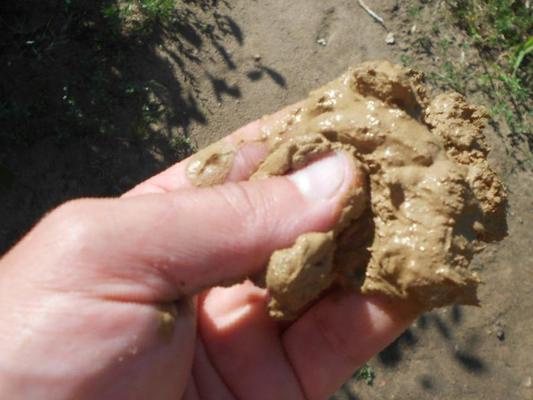

You can determine the fat content of clay rock in the following way. Roll up the rope of clay, assuming a thickness of 10-15 mm and a length of 15-20 cm. Wrap them in a wooden form with a diameter of 50 mm. If the clay is oily, then the tourniquet is stretched gradually, without cracking. Normal provides a smooth stretch of the rope and breaks, reaching a thickness of 15–20% of the original diameter.
Types of heat-resistant mortars for laying brick ovens
The choice of composition for work can be carried out based on the masonry of a certain component part future structure. To optimize all functions of the stove or fireplace, it is better use different solutions: for the foundation, for the heating part, for the reinforced concrete base ("pillow").
When working on the arrangement chimney the requirements for heat resistance and fire resistance are slightly reduced, with plastering other types of mixtures are used. In compositions for masonry may include such substances:
- clay;
- sand;
- cement;
- asbestos;
- gypsum;
- lime;
- salt.
Components can be mixed with each other, they are added modifying agents, plasticizers.
Clay
Centuries ago, during the construction of the Russian stove, it was necessarily taken into account that the walls of the structure would be exposed during operation high thermal stress... Since then, nothing has changed, this remains an important condition.And one of the materials showing positive properties, which is not only a binder, but also a plasticizer, is ordinary clay.
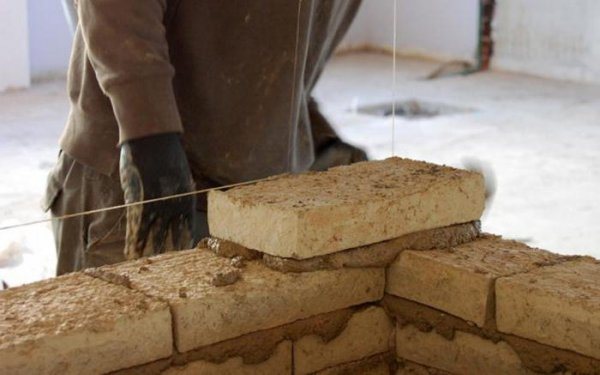

Photo 2. Clay mortar applied to the bricks from which the oven is laid out.
The composition for masonry was made by hand, it had to have the following properties: fat, viscosity and density... Therefore, the clay was used greasy and carefully sifted, calcined river sand and ordinary clean water were added to it. After drying, the composition cracked, the cracks were repaired with a lean or medium solution.
The composition for masonry based on fine-grained sedimentary rock is divided into three types based on consistency:
- fatty (the most flexible);
- skinny (least plastic);
- middle.
The peculiarity is that a solution of high fat content after drying can crack, a skinny one - crumble. For the masonry of modern stoves or fireplaces, it is used normal (medium) solution.
The unique properties of clay are that it gains high strength after firing, gives structure adhesion and is resistant to extremely high temperatures. Clay is made of fire-resistant ceramic and clinker bricks.
If the mixture is prepared entirely by hand, it should contain the optimum ratio of all components. The composition will be as follows:
- sifted clay;
- washed and sieved sand;
- pure water.
Most often, in the work on arranging the furnace, it is precisely clay-sand mortar... The simplest composition can also be used, which includes water and clay, taken in equal proportions. They can fluctuate in one direction or another, depending on the type of clay.
To make the optimal solution, you will need to do some experiments with clay, so it will be clear how plastic it is. To do this, you need to take approximately five samples of material... Add sand to the first sample in an amount 10% from the amount of clay, to the second - 25%, to the third - 75%, to the fourth - equal parts of sand with clay, and leave the fifth sample unchanged.
Add water to each composition and mix thoroughly until creamy consistency, then lower a wooden plank into each. If the composition is ideal, then it will remain on the wooden surface in a layer thick no more than 2 mm.
Reference. You can add common salt to the mixture for added strength.
If the clay does not hold at all, then this is a non-plastic composition, and it not suitable... Too thick layer of the mixture adhering to the board indicates superplasticity, which is also not an ideal performance for work.
You can buy sand for the composition or stock it yourself. When buying, you need to give preference lake or mountain species... To prepare the mined sand, it must be sieved from coarse fractions. If it contains organic matter, then the sand also needs washing.
Important. When using a commercial solution, you need to knead as much clay as you can spend in one hour of work.
Clay can also be used to lay bricks around a metal oven.
Fireclay
This is a mixture based solution quartz sand and ground refractory clay. Its parameters will be the same as for ordinary clay mortar, namely:
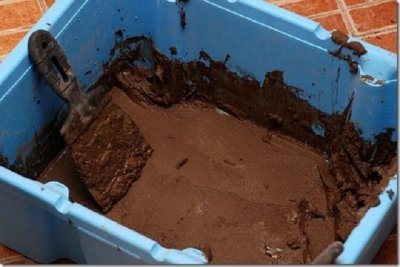

- absolute fire resistance;
- maximum gas tightness;
- unsuitability for masonry outdoors;
- suitability unlimited time;
- dryness, restores all properties after wetting.
One parameter will differ - this is the heat resistance indicator. For fireclay solution, it is higher, approximately 1200-1300 degrees... For masonry chimney and creating furnace zone it is the clay-chamotte solution that is needed. It is prepared in the ratio 1 to 1 (fireclay and clay), ¼ water from the mass of clay.
Important! A mixture with refractory clay in the composition can be used for cladding, but not earlier than through 4 weeks since the beginning of intensive operation of the furnace.
Lime
There are compounds that can replace clay, but they are used for specific structural components:
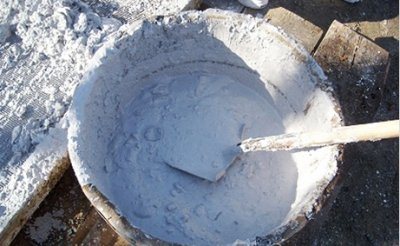

- chimney;
- first rows of masonry;
- monolithic foundation;
- trumpet.
The lime mixture is prepared for plastering ovens, but also used when laying a foundation, chimney, pipes above the roof, that is, for those constituent parts of the building that will not heat up more than 450-500 ° C.
The strength of the slaked lime composition is higher than that of clay, but gas density lower... This material can be used outdoors. The composition has good moisture resistance, increased mechanical strength, resistance to smoke transmission.
Attention! Quicklime is not used in the formulations, as this leads to breaking fresh masonry due to the peculiarities of the interaction of this component with water.
Cement. Which oven mix is best?
Cement-sand or lime-cement mortar is used to equip the bottom of the combustion chamber, base, pipes above the roof, leveling surfaces, it is used to putty joints. The composition is different high strength and fast solidification.
Important! Cement-sand mortar "does not breathe", has poor tolerance to exposure to high temperatures.
The composition with cement turns out to be very strong, and depending on the additive (lime or chamotte), it will have low or high heat resistance. A mixture of cement and slaked lime allows you to use the composition in the foundation device in damp places... For chimneys, it will not have a suitable heat resistance, its heat resistance no more than 250 ° C.
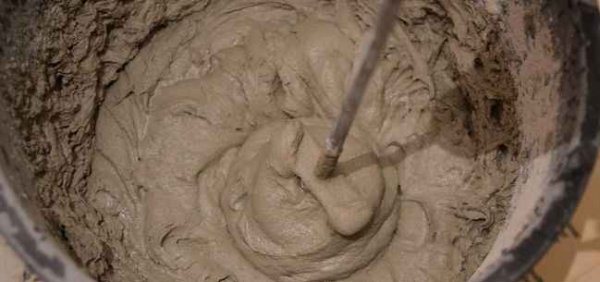

Photo 3. Mixing cement-sand mortar using a construction mixer. A similar mixture is usually poured into the foundation of the furnace or laid out the chimney.
Cement with the addition of chamotte is resistant to temperature, about 1300 ° C, it does not allow flue gases to pass through and allows condensate to escape. The mixture is heat-resistant and refractory, but it is more expensive than a clay mixture.
Reference. The best mortar for laying the firebox will be clay-chamotte. The mixture must have excellent thermal efficiency in order to withstand increased thermal loads.
Clay components of mortars for brick heaters
Fireclay refractory kaolin clay is best suited for masonry ovens
The clay composition differs depending on the added components:
- clay-sandy;
- clay-cement;
- clay-limestone.
Stove makers usually choose the first option. Fractional proportions depend on which clay to use for the oven. If it is oily, the ratio of sand will be 2: 1, if it is medium fat - 1: 1. Also, with good quality clay, you can do without additives.
The strength, reliability and pleasant appearance of stoves and fireplaces largely depend on the quality of the masonry mortar with which they are laid. If some component is not enough or too much, the seams will crack. As a result, smoke from the stove will begin to pass into the room, and fuel costs will increase, since due to excess air supply, it burns faster. Or you can not waste time calculating the proportions, but buy a ready-made composition.
We offer you to familiarize yourself with: The project of a bathhouse with a flat roof. The roof of the bathhouse - basic recommendations for the selection of the type and instructions for building (90 photos)
Masonry mixture for fireplaces and stoves consists of a binder, aggregate and water. If there is only one knitting element in it, then it is considered simple, if two, then complex. The main characteristics are strength and ductility. At the same time, according to plasticity, they are divided into 3 types: skinny, normal, fat.
Clay is a sedimentary rock of fine-grained structure, the forming substance of which is kaolinite, consisting of a mixture of silicon oxides (47%), aluminum (39%) with water (14%).The name kaolin comes from the Chinese area of Kaolin, where such white clay was first discovered. In the presence of iron ions of various valences in kaolin clay, the color of this material can be different - yellow, red, brown, blue, green, but this has little effect on the physical properties.
Clay pit and a clay sample of plastic consistency
Chamotte is a powder obtained by crushing pieces of clay that have sintered during high-temperature firing and have lost molecularly bound water. The size of the chamotte crumb fractions after crushing or grinding is from 0.2 to 2.5 mm. Sifting chamotte powder allows you to separate fractions by size, after which finely ground powder is often called chamotte clay, and coarse - chamotte sand, but the chemical composition and properties of these materials are identical - high heat resistance and low water absorption.
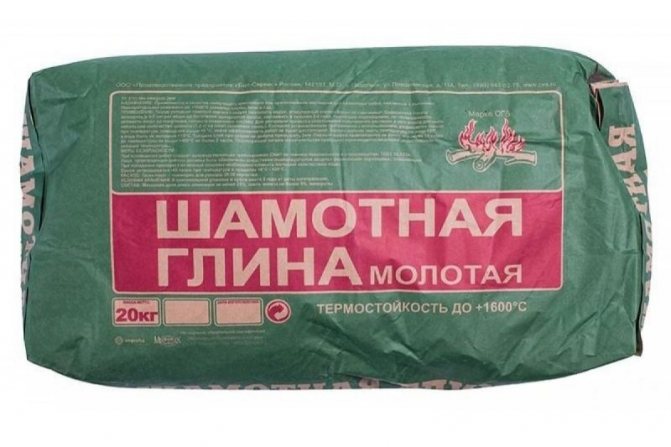

Fireclay filler of industrial production and packaging
The degree of clay sintering depends on the value (or) and duration of high-temperature exposure, which determines the division of chamotte into:
- low-burned - firing temperature 600-900 C, water absorption up to 25%;
- high-burned - for ordinary firing at 1300 C and water absorption is less than 5%, for special-quality ones - at 1500 C with water absorption of less than 2%.
Masonry mix for different parts of the oven
Different masonry mixes for ovens are used in different parts of heat-resistant structures. In places where there is exposure to open fire and higher temperatures (firebox, combustion chamber), a solution is needed that can withstand their exposure. Outdoor finishing work can be carried out using mixtures with a lower heat resistance. Let's take a closer look:
- For masonry of the furnace core and the internal circuit of the combustion chamber, Mortar is perfect, which has excellent adhesion to refractory fireclay bricks. It can easily withstand the effects of open fire, because the combustion temperature of dry birch firewood and coal can reach 1500 degrees C, and the refractoriness of the Terracott mortar is 1780C.
It is also possible to use a clay-chamotte mixture for laying the internal circuit of the combustion chamber (firebox), but on condition that high-calorie types of fuel will not be used when firing the furnace.
- We recommend laying all subsequent outlines of the ceramic brick firebox with a clay-chamotte mixture "Terracotta".
- For laying the outer walls of the stove, use a special masonry mixture for outdoor work "Terracotta". Its advantage is the fact that it does not require temperature exposure for curing. During operation, the material will not crumble, crumble, and cracks will not form.
- For laying the inside of the pipe exposed to high temperatures, also use a clay-chamotte mixture.
- Use outdoor masonry mortar for the front lining of the pipe. It is moisture resistant, not afraid of precipitation, temperature extremes and other environmental influences.
Consider these nuances when choosing a mixture for ovens.
You will need 3 types of mixtures for work in general: highly plastic refractory mortar, clay-chamotte mixture and a mixture for outdoor work.
Methods for removing impurities
The kiln solution requires clean sand. To separate it from impurities, it must first be sieved and then washed. For sifting, a fine-mesh sieve with a mesh size of 1.5 mm is used. Next, the sand is washed like this: a sacking with a sagging is pulled onto the holder (a kind of net should be obtained), into which the sand mixture is placed.
The clay is stirred with water and left to soak
To remove impurities from the clay, it is washed. Crushed, placed in the upper part of an oblong container (for example, an old trough or bath). Place the container at an inclination of 4–8 °. Water is poured into the lower part so that it is at the top and does not touch the clay.Clay is washed with a small spatula or iron scoop.
The sand is sieved through a fine mesh sieve
If you bought a packaged dry clay, you need to soak it. The process of saturating clay with water is quite simple. For work, a wide and deep container is taken, dry clay is poured to a level of 10–20 cm, leveled and water is added. The amount of water - so that everything is completely covered. After a day, it is thoroughly mixed with a shovel, if necessary, liquid is added and again left for the same period. When everything turns into a paste, we can assume that the clay is ready. This is repeated several times until all the required amount is soaked.
The first step is to remove impurities from the natural clay stored for oven laying. There are different ways to do this.
Dry punching
You can wipe the clay through a sieve dry or soaked
The most primitive way. Use your hands to select everything that is superfluous - grass, pebbles, debris, grind large lumps. After that, the plastic material needs to be rubbed through a metal sieve with cells of about 3 mm.
The method can be made slightly less laborious by drying the clay. To do this, clay lumps are laid out on a wooden canvas and dried in the sun. In winter, this is done in the cold, laying it under a canopy so that it does not get covered with snow. With a small amount of material, they are placed indoors, on a heated stove or on a heating radiator. The speed of drying depends on the size of the lumps: the smaller they are, the sooner they dry.
Pour the dried clay into a box with thick walls and grind with a rammer. After grinding, clay dust is sieved through a sieve with fine meshes to remove various inclusions from it: pebbles, chips, and other debris.
"Dry punching" is a rather laborious task, therefore it is more expedient to soak the clay after manual cleaning for 2-3 days.
- Place the material in a large basin in 12-15 cm layers, wetting abundantly.
- Pour in water at an approximate ratio of one to four to the clay.
- When the mass is soft, mix with a concrete mixer or other means.
- Wipe through the wire mesh 2–2.5 mm.
The bottom layer - sand and stones - is not suitable for bonding bricks
There is also an older way of torturing:
- Several holes are drilled vertically in a wooden container with a small distance between them.
- Each of them, before filling the tub with a liquid clay mass, is muffled with a wooden stopper.
- Grains of sand and a variety of small stones precipitate first due to their greater weight.
- Subsequently, after settling, clay particles settle to the bottom.
- The upper layer of water gradually becomes lighter, but you need to wait until the liquid becomes transparent. As soon as the border of the clarified moisture drops slightly below the first hole from the top, remove the plug. The settled water flows out of the container.
- After the appearance of the next level of settled liquid, take out the next plug.
This process is repeated until all clarified water is completely drained. To speed up the precipitation after loading the solution into the tub, you will need to add bitter Epsom salts - about one pinch per bucket. If there is no wooden barrel at hand, it can be successfully replaced by a metal container suitable in height and volume. The principle of operation is the same with one difference - first, short lengths of pipes are soldered into the holes, and plugs are installed in them.
When all the settled liquid is drained, the liquid clay is transferred to a wide box and left in the sun to evaporate excess moisture. After the dried material ceases to be fluid, stir it periodically with a shovel. As soon as the mass becomes similar in texture to thick dough and stops sticking to the palms, it is covered with polyethylene or oilcloth and stored until the start of the oven work.
Clay solution and technology for its preparation
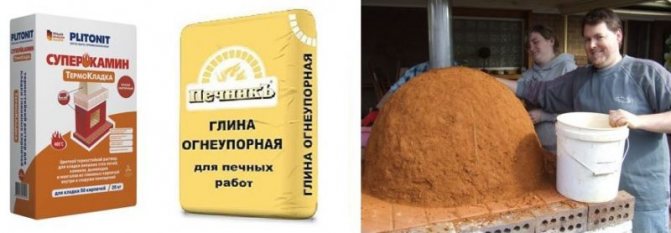

For the construction of the foundation and the chimney, it is recommended to use a composition based on lime and cement.
A special dough made by mixing quicklime and water in a 3: 1 ratio. Sifted sand is added to the finished dough through a fine mesh sieve in a ratio of 3: 1 - for 3 volumes of sand 1 volume of dough. The finished mass is diluted with water until a thick mass is obtained.
A lime-based mixture for laying a kiln turns out to be quite plastic and durable.
The fat content of the lime composition is determined by the amount of sand. For an excessively fat mixture, 5 volumes of the sand component are required, for a normal one - no more than 3 volumes.
Strength and water resistance can be increased by adding cement. To prepare such a composition, it is necessary to use components in the following proportions (parts):
- Cement - 1;
- Sand - 10;
- Lime dough - 2.
The preparation of the solution has the following sequence of actions: cement and sand components are combined in a separate container. The finished lime-based dough is diluted with purified water until a thick consistency is obtained. Bulk components are introduced into the diluted dough and mixed. To increase the viscosity, the composition is diluted with water.
The main characteristic parameter of this material is fat content, which combines the degree of plasticity, strength, water resistance, as well as adhesion before and after curing.
In nature, there are three types of clay - lean, medium fat and oily, there are no clear boundaries between them.
The belonging of a material to one of the types is determined by simple mechanical manipulations, the most accurate of which is performed as follows.
About half a kilogram of clay is mixed with water until a homogeneous pasty consistency is obtained, after which a ball with a diameter of about 5 cm is formed from the resulting mass.
The ball is placed between two pieces of glass, which are slowly squeezed, observing the formation of cracks in the clay:
- the destruction of the ball at the beginning of squeezing indicates a low fat content - thin clay;
- the appearance of thin cracks after reducing the diameter of the sample by 1/3 of the initial value indicates that the clay is of normal fat content;
- if cracks appeared only when the ball was squeezed to half the diameter - a mass of high fat content.
We suggest that you familiarize yourself with: How to overlay a stove in a bath, a diagram of a brick lining of a stove in a bath (13 photos)


Determination of the fat content of clay by squeezing: on the left - fat, on the right - normal.
The main factor affecting the fat content of clay is the percentage by weight of sand in it:
- 15 to 30% are skinny;
- from 5 to 15% - medium fat;
- up to 5% - fatty.
When performing furnace work, different solutions are prepared and for different purposes:
- installation of the foundation;
- oven masonry;
- plastering and facing work.
For these purposes, solutions are used:
- clay;
- lime-clay;
- sand-cement;
- lime.
The stoves are placed on a clay mortar, adding a little salt or cement for strength. Many people use only clay with water, no additives. To facilitate the mixing of the solution, some stove-makers make wooden flooring from boards with low sides. The wide working area of mixing allows for better preparation of the solution.
The stoves are placed on a clay-sand mortar
First you need to determine how much material you need. The calculation is as follows: when laying 50 pieces of bricks flat with a seam thickness of 3-5 mm, about 20 liters of masonry mixture will be required (increase by 15-20% if we are building a Russian stove).
Clay mortar is used for the main structure of the kiln, it can also be used for cladding. Consists of clay, water. Aggregate is sometimes added: sawdust, shavings, construction sand. The clay mixture is prepared in the following proportion: 1 part of filler is added to 2 parts of clay. More often than others, clay-sand mortar is used for laying the furnace.
The components are mixed into a homogeneous mass until a creamy state. The masonry mass should come off the shovel well and leave no marks. Also, separable water should not appear on the surface - if this happens, you need to add sand. To give greater strength, salt is added to the solution: 100–250 grams per bucket of solution. Less commonly, cement is used - 750 grams per bucket.
How to prepare a mortar for laying stoves is demonstrated in the video material. At the same time, you will see the consistency to which you need to soak the clay.
Sand-cement mortar is used to level the surface irregularities and lining the furnace (tile, mosaic, stone). Cement mortar for the kiln is used for sealing joints, when laying the foundation. It is prepared as follows: the required amount of building sand and cement is measured, mixed well, poured with water to the desired consistency - such a state when it is sufficiently mobile and squeezed out of the seam without much pressure. The proportions of materials depend on the brand of cement composition, most often 1: 2.
Lime is used as a mortar for plastering ovens, for laying foundations and pipes. Cooking it is fundamentally different. First, lime is slaked and kept in a special pit for about a week. After that, a solution is prepared with sand. The C ratio depends on the fat content of the lime (usually 1: 2 or 1: 3).
For plastering the furnace, lime-clay mortars are used with the addition of asbestos to give greater strength. The proportions of the solutions are as follows:
- clay-lime dough-sand-asbestos 1: 1: 2: 0.1;
- clay-sand-cement-asbestos in the same ratio;
- gypsum-sand-lime dough-asbestos 1: 1: 2: 0.2.
The cooking technology consists in combining all dry components and adding clay, gypsum or milk of lime diluted with water. Then the components are mixed until smooth.


There is a refractory (chamotte) mortar for laying the core of furnaces. For its preparation, chamotte and refractory clay are mixed in a 1: 1 ratio, then water (one fourth of the clay mass) is added and mixed well.
This is what a good solution looks like on fireclay brick
It is necessary to monitor the quality of the solution. After all, only a sufficiently plastic composition is able to ensure good adhesion of the oven masonry and the tightness of the seams.
Clay is one of the best options for laying a brick oven. But you should not use it for chimneys and foundations, as it collapses due to high humidity. For manufacturing, you will need fine sand (up to 1 mm) and good quality clay. The sand must first be sieved through a sieve to remove debris and small stones.
The maximum temperature that the clay mortar can withstand is 1000 ° C. Moreover, its volume during heating changes in the same way as a brick. Therefore, the masonry remains intact and strong. Compared to others, the consumption of the clay mixture is higher. So, for laying hundreds of bricks, you will need 2 buckets of clay and one and a half sand. Consumption can be reduced if the composition is passed through a sieve, and the seams are made thinner and use a building material that is even without chips.
It is recommended to pre-soak the clay in two days, then it will become more plastic. To make the composition as thick as sour cream in consistency, the clay is passed through a sieve, in the same way the sand. After mixing with the desired ratio of components, it is sieved again. Then it will turn out to be as homogeneous and high quality as possible.
Guide: how to check quality
To find out the quality of clay and whether it is suitable for laying fireplaces and stoves, you should make several solutions with different proportions, or rather, 5 mixtures consisting of the following components:
- clay without any additives;
- the same ratio of clay and sand;
- clay and 10% fine sand, as well as 25 and 75% sand.
Each of the five compositions is thoroughly mixed dry, and then water is poured.It is added until the mixture looks like a thick dough that sticks to your hands. To check for quality, the same amount of test is taken from each. The resulting portions are formed into balls with a diameter not exceeding 5 cm.
But you can use a faster way to check for quality. The ball fits between two boards slightly larger than itself. After that, the top board is pressed on it until cracks appear. If they appeared immediately, then it has weak plasticity, which means that the ratio of the components is chosen incorrectly.
Such a composition cannot be used for a brick oven. If cracks began to appear in the ball only after compression by 30%, then the proportions of the components were selected correctly. It is considered the best option for laying fireplaces and stoves. If cracks appeared only after the ball was flattened by half, then it has too high plasticity.
Truly working legal way to save money. Everyone needs to know this!
There is another method of quality control. For this, tourniquets are made and wound on a stick 5 cm thick. If no cracks appear on it, this indicates high plasticity, the tourniquet is cracked and torn - low plasticity. If rare cracks are visible, and it remains intact, a solution of good plasticity with the correct ratio of all components.
For the construction of the foundation of the furnace and the construction of a chimney above the roof, formulations with lime are used. You will need water, sand and lime dough. To increase the strength, cement is added to it, and gypsum is added to reduce the setting time, but it is usually poured only for plastering work.
The quality depends entirely on the lime dough. An amount of water is poured into powdered or lumpy lime so that it cannot boil. The dough preparation process takes almost half a month. During this time, it should be covered with a little water. The ready-made lime must be stored for a month before using it to mix the solution.
Methods for the selection of the ratio of clay and sand
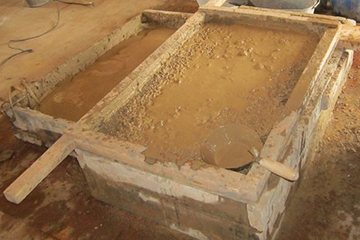

The mixture will include three components:
- Clay.
- Water.
- Sand.
Many people are interested in the proportions of clay and sand for laying the stove. In what proportions to mix these components in your case, no one can say, since the quality of clay in different places is completely different.
The finished composition should be plastic, but not too greasy, and not too dry (skinny, in which there is too much sand). A fatty solution, drying out, decreases in volume, cracks. Skinny can crumble, it is not strong enough.
The properties of clay are determined by its proportional composition (sand, SiO2, Al2O3 and other impurities).
The fat content of the clay and how much sand will need to be added is determined experimentally.
Clay fat test
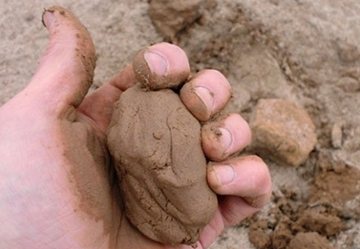

The trial is very simple.
A lump smaller than a fist is taken, with wet hands it kneads and rolls into a ball.
The ball is placed between two smooth boards (metal or planed boards) and slowly begins to squeeze.
This is done until cracks appear.
Ideally, cracking should occur when the ball is compressed by at least 1/3 of the diameter. After a couple more tests, which will also show a positive result, you can put a brick on such clay! However, such luck does not happen often.
If the clay ball is cracked almost immediately, there is a lot of sand in the composition. If it smoothly shrinks by more than half, the clay is too oily.
At what depth should the clay be taken for the oven solution. The upper layers usually contain loam. Lean raw materials with a high proportion of sand. Clay, as a rule, is located lower and the deeper, the more its fat content increases.
Flagella
The bundle is 15-20 mm thick and 200-250 mm long. A freshly rolled tourniquet is wrapped around a stick 40-50 mm in diameter. Normal result - small cracks will appear on the surface. Will not crack at all - oily.And it will crack with deep cracks - skinny.
Other checks: ball and cake
A ball rolls around and a small (4 - 5 cm in diameter) cake is made. Both samples are completely dry, this will take 2 to 3 days.
If during this time the edges of the cake are severely cracked, the clay is oily (add a little sand and repeat). A sign of a lean composition will also be that the cake crumbles from pressing.
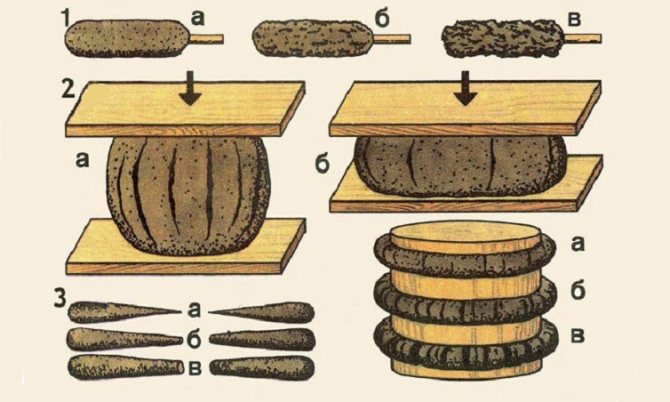

Methods for checking clay solutions
The ball falls to the floor from a height of 1 m. If it has completely collapsed, there is a lot of sand in the raw material (skinny). The best samples do not break at all (acceptable result if the sample breaks into 2-3 large pieces).
Skinny clay is the most inconvenient material to work with. It is quite difficult to make it oily. For this, the raw material must be tortured. The procedure consists in repeated stirring in water and draining after the solid particles have settled. Sometimes stove-makers mix several clays. By mixing normal or high fat clay to a lean sample, a satisfactory composition can be obtained.
It is believed that a brick oven is difficult to build. This is true, but it is quite possible to build a small stove yourself. Do-it-yourself brick stove for a bath - the necessary tools and instructions for laying.
How to make a hood in a private house, see this topic.
The installation of a sauna stove is a crucial stage, because the safety of its operation depends on the correct installation. Here https://microklimat.pro/otopitelnoe-oborudovanie/pechi/ustanovka-v-bane-svoimi-rukami.html the rules and order of installation are described in detail.
Clay components of mortars for brick heaters
One or another type of clay oven mixture purchased in a store is prepared according to the instructions on the package, there are no questions here.
If it is decided to use a home-made mortar for laying the stove, then the main conditions on which the quality of the mixture preparation depends are two - the correct preparation of the components and the observance of the proportions of the components.
Using the example of a clay-sand mortar, we will consider the preliminary operations and mixing rules.
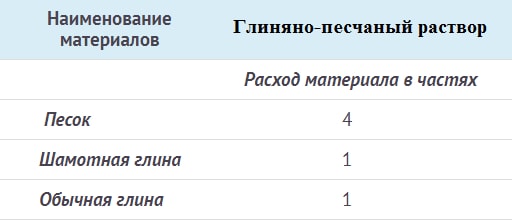

Using the data in this table as a basis, you can achieve high quality masonry mortar by slightly adjusting the proportions with reference to the parameters of the components used.
The natural clay prepared for the stove must be cleaned of foreign impurities - everything foreign (plant remains, stones, debris) is manually removed, and large lumps are broken. Then the mass is rubbed through a metal mesh with a mesh size of approximately 3 mm.
We suggest that you familiarize yourself with: Mortar for laying a brick oven: proportions and how to prepare
Such "dry punching" is a laborious procedure, therefore it is more rational to pre-soak the manually cleaned clay for 2-3 days in a tin trough - lay in layers of 12-15 cm, wetting them abundantly, then cover the entire bookmark with water (approximate ratio: 1 part of water per 4 parts clay). After 2 days, mix thoroughly with your feet or with a mixer and rub through a sieve with a mesh of 2-2.5 mm.
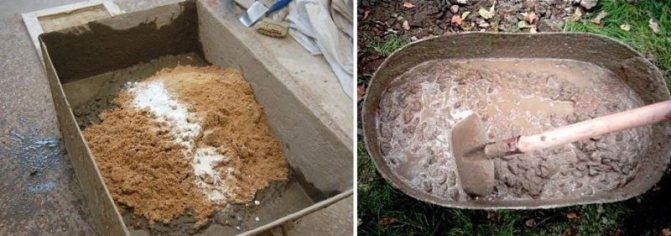

Ways to soak clay
Sand is prepared during soaking. Fireclay sand does not require preparation, except that it is sieved if purchased in bulk. And river sand must be sifted through a sieve with a mesh of 1-1.5 mm, then rinsed with running water in a container until the turbidity disappears and laid out on a clean inclined plane in order to remove moisture residues as much as possible.
There is no strict ratio of the volumes of these components, since any clay initially contains some amount of sand. Therefore, the proportion can be from 1: 2 to 1: 5, ideally the clay should only fill the voids in the solution between the grains of sand.
In order to have an approximate idea of the volumetric ratio of the components, the bucket is filled 1/3 part with a clay suspension when it is ready, and then sand is poured along the edge. The materials are thoroughly mixed in any container to the desired consistency with the addition of the required amount of water.The readiness of the mixture for laying the furnace is checked as follows - it should be held on the trowel after turning its plane by 1800 and slide off it when it is in a vertical position.
Testing the readiness of clay-sand mortar
If the mixture falls from inverted to 180
base, then you need to add clay to it. If the solution does not slide off the vertical plane, add sand. After correction, the check is repeated.
Having tested the solution in this way, an approximate volumetric ratio of the components is obtained.
Clay-sand mortar is used in furnace zones with temperatures up to 1000 0C. Full or partial replacement of river sand with chamotte sand allows you to use the mixture for laying a furnace with an operating temperature of up to 1800 0С, including in places of direct contact with a flame.
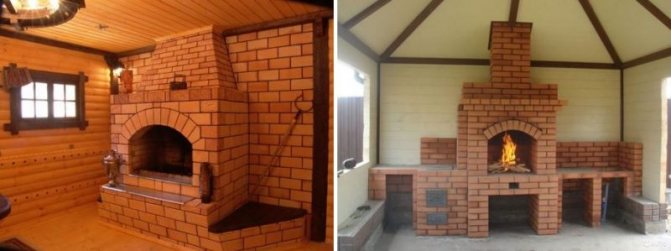

Variants of the classic style of stone ovens
Selection and preparation of sand
The simplest solution contains clay and sand. The best sand is traditionally considered to be mountain sand - it has a rough surface texture, due to which the solution significantly enhances the quality of the connection of masonry bricks. Sea and river sand against the background of mountain sand turns out to be not so good - water polishes the surface of the grains of sand, as a result of which they lose their bonding properties.
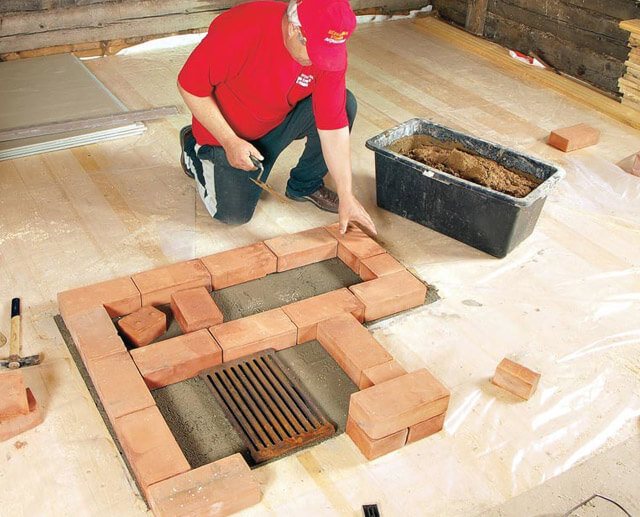

It is recommended to sift the sand through a sieve with 1.5 mm meshes immediately before creating the solution. If, even after sifting, there are impurities visible to the eye in the sand, then it must be rinsed with water. The sand for washing is scattered on the stretched burlap, and a stream of water is directed at it. The flushing can be finished only after the water, after passing through the sand, becomes clear.
Proportions and mixing of the solution
You can not add sand to clay of medium fat content - it has the correct proportions of the components 1: 1
In addition to cleaning before mixing, the clay for laying the stove must be prepared. The material is laid out in a box or barrel upholstered with metal, filled with water so that the liquid covers it entirely. If there are large lumps, they need to be broken into smaller pieces in advance. Everything is mixed well and left for a couple of days.
The clay composition should be of a pasty consistency, without impurities. If, after 48 hours, small lumps are found in the mass, it must be mixed again, all the seals must be broken and kept for another day.
After preparation, you can start preparing the solution. If clay is mixed with sand, the latter is poured into a prepared container, then plastic material is laid out, and a sand layer is again poured over it. A shovel is used to mix the components. If moisture appears at the top, add a little sand. Topping up with water is required in an overly dry composition. The solution can be considered ready if it slowly slides off the shovel and becomes uniform.
If the base is medium fat, you do not need to add the sand component. Step-by-step instructions for breeding clay without sand for the stove with your own hands:
- The material is laid out on a wooden platform in layers, each layer is moistened.
- Upon reaching a height of 30–35 cm, the mass is mixed. For this purpose, you need to spank the upper layer with the back of the shovel.
- The kneading continues until a homogeneous substance is formed.
You can check whether the masonry clay has been prepared correctly for the oven as follows: apply a thin layer on the red brick, put another block on top and leave it for an hour or two. If, when lifting the upper brick, the lower one does not fall off, you can use the composition for the construction of the stove. The clay sets for a long time, you can immediately mix the required amount of binder. It will take about 20 liters to lay out a 50-brick stove for a bath, and to build a Russian stove 15-20 percent more.
Failure to comply with the proportions of the components of the solution lead to cracking of the structure
How to dilute clay for oven putty:
- The dry base is ground and soaked.
- Sand with lime or cement is introduced. Proportions of medium-fat clay with sand and lime 1: 2: 1. When including cement powder, it is necessary to proceed from the amount of the sand component in a ratio of 1: 3.
- To make the plaster layer stronger, you can add asbestos, fiberglass, hemp or straw in a ratio of 1: 2: 0.1 (clay / sand / additives).
When additional ingredients are included in the clay solution, they are first mixed with each other, and only then with the previously soaked clay.
The plasticity and fat content of the masonry mortar are regulated by the addition of sand. You can determine the proportions as follows:
- Take a little clay and distribute it into 5 equal parts, of which we put sand in the amount of 1/4, 1/2, 1 and 1.5 in 4 portions, and leave one without sand. After adding water, we knead each separately. The resulting blanks must be plastic and not stick to your hands. Flat pancakes are formed from them and dried. The quality of the mass is determined in this way: if the workpiece crumbles, then there is more sand than necessary, and the presence of cracks indicates its lack. It is optimal if the sample remains without cracks and is homogeneous.
Good mortar does not crack after drying
- You can do it easier: moisten a spatula in water and lower it into a clay solution - if the batch does not stick and the trowel gets almost clean, then the solution is suitable for masonry. In case of sticking, add sand, the clay is oily.
- Leave the clay solution alone. If after some time he pushes water to the surface - the clay is skinny, you need to add more of it to the batch.
- Dilute a bucket of clay with water until it becomes sour cream. Dip a wooden stick into it and determine the thickness of the adhered layer: if 1 mm and insignificant plasticity, you need to add clay, if the layer is thick and too plastic, gradually add sand (1 liter per bucket). It is necessary to achieve normal fat content, that is, adhesion of a layer of 2 mm and individual clots.
Having determined experimentally the necessary proportion of the ratio of sand and clay in the future solution, we proceed to the preparation of the basic materials.
Method number 1. Stages of preparation of a high-quality solution
First of all, remember: cement mortar in its classic form (sand to cement ratio 3: 1) can only be used for the foundation. As for the construction of the firebox itself, only a special clay solution is used there for laying furnaces.
What does the solution affect
- If you pour 20-30% more sand than necessary, then during laying there will be problems with the ductility of the seam, the brick will draw water from the masonry mixture, and it will begin to crumble, plus during operation the blocks will need to be well soaked and only then laid in a row;
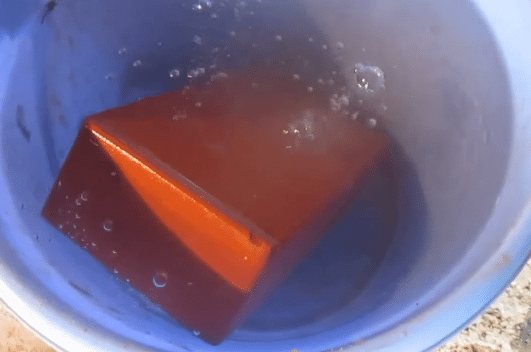

It is advisable to soak the brick before laying.
The same can happen when using bricks with high water absorption, for example, the products of the Kirovo-Chepetsk plant.
- Too greasy solution is less common, and in this case the result will not be long in coming, literally the next day you will see large cracks in the seams and just reposition them again;
- It is much worse if the error is not in proportion, but in the quality of the clay itself, that is, initially, the clay will contain too large a percentage of black soil and other inclusions. After drying, such a mortar for oven masonry is easily pulled out of the seams, and sometimes even with bare hands.
Procurement of material
| Illustrations | Recommendations |
| Soak the clay. The preparation of mortar for masonry ovens always begins with soaking the clay. The instruction requires soaking it in water for at least a day, but if you do not have time, then for half an hour every 5 minutes you need to thoroughly mix the composition with a construction mixer and then you will get almost the same result at the exit. For oven mortar, it is easier to use ready-made, purchased clay, packaging can be different, but I prefer to take in bags of 25-27 kg. |
| Cooking sand. While the clay is soaking, you can sift the sand. For both sifting sand and wiping clay, I use a mesh with a mesh size of 2 mm. Sand should be taken exclusively from quarry, because silty inclusions in river sand will give a sharp and strong shrinkage of the sand and clay solution, this will be especially noticeable on the masonry of corners and arches.
|
| Exact weight. The preparation of a mortar for laying a stove is a delicate matter, and in order to choose the right proportions, it is desirable to know the weight, at least approximately. I measure out with a 20 liter plastic bucket, 27 kg of dry sand is placed under the eyeballs. But you can use other containers, the main thing is that you know how much material is included there. |
| Filtering the clay. To prepare a solution from clay, you need to mix the liquid infused clay again, then strain and rub through a sieve with a cell of 2 mm. So you will remove all the small debris and pebbles that must be in it. If you are making a mortar for oven masonry for the first time or from unknown clay, then initially 10-12 liters of water should be taken for 27 kg. Then I add water, liquid clay or sand as needed, but more on that later. |
| Factory mixes. For the sake of fairness, I want to say that the quality of the solution is not low in all factory mixtures. I have tried many manufacturers and I can say with confidence that the products from the Makarovykh house are really good, only the price is several times higher compared to the homemade mixture. |
It is better to buy clay in one place and from the same batch, different batches may have different fat content. If you decide to dig up clay with your own hands, then know that you need to take a homogeneous mass from a depth of at least 1 m, there it is cleaner.
To roughly determine the fat content, the clay must be diluted with water and left for half an hour in the sun. The more cracks there are after drying, the higher the percentage of fat content of the clay.
If you still decide to buy clay, then take it in specialized stores for stove makers, where everything is sold on a turnkey basis. Such shops, as a rule, are "kept" by the masters themselves and they can really advise you something, and large supermarkets are a conveyor belt and it is useless to look for high-quality clay there.
How to find the right proportion of mortar
The clay and sand have been prepared, now let's talk about how to make the oven solution itself. Not one competent stove-maker will tell you the exact universal proportion, the fact is that the fat content of the clay is always different, which means that the proportions of the solution will also be different. At each object, I select everything empirically, and then I will show you how to do it.
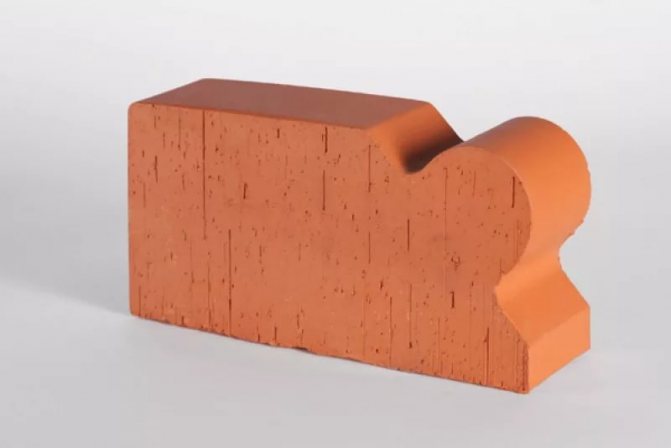

Shaped solid facing bricks are a good way to make your stove design unique.
For clarity, I'll take 3 different types of solid red bricks:
- The simplest and most affordable brick of the M-150 brand;
- Facing brick "Lode", brand M-500;
- Kirovo-Chepetskiy building brick of the M-250 brand.
I took these stamps, because they are closer to me and I have already worked with them, if they are not there where you live, then take the brick that is and experiment with it, here the main thing is to understand the principle itself.
| Illustrations | Recommendations |
| Putting on clay mortar. Before applying the mortar to the brick, the blocks must be washed or at least wiped with a wet rag, while they should not be soaked, otherwise we will not be able to understand the level of adhesion of the mortar.
In order not to confuse the samples later, I mark each batch. In this case, I applied clean clay (no sand) and I leave this brick unmarked. |
| Clay with sand. Now I add the same amount of sand (27 kg) to a container with diluted clay, add water and mix everything thoroughly with a mixer. As a result, we got a solution with a ratio of 1: 1. |
| I designated this batch with the Roman numeral 1. |
| Quick determination of the quality of the solution. There is a simple way to determine the quality of a clay-sand mortar:
|
|
|
| Add sand. Now add about half of the sandbag to our mixture to get a 1: 1.5 ratio. Naturally, add water and mix everything. It is believed that with such a solution, it is already possible to lay a porous brick with a high absorption level on a thin seam. We mark these samples with the Roman numeral 2. |
| Proportion 1: 2. Now add another half bag of sand, water and mix again. Ideally, after each stirring, let the solution brew a little for 5-10 minutes, no more. We mark this batch with the Roman numeral 3. Also in this batch we will make a separate sample with a solution from the Makarov oven house and designate it with the letter “M”. |
| Proportion 1: 2.5. This solution already does not adhere well to the trowel and when descending, the creak of sand on metal is clearly audible, plus individual particles of sand are felt by hand. Such a composition can be used for laying bricks with low water absorption, on a wide seam of 8-10 mm. The seams should not crack, but due to the low plasticity of the composition, difficulties will appear with the shrinkage of the brick. In the same way, we apply the composition to the brick and mark the samples with the Roman numeral 4. |
| Proportion 1: 3.5. To bring the experiment to the end, I decided to make another batch in a ratio of 1: 3.5. To be honest, this composition is already more like simple wet sand, it practically does not hold on to a trowel and is hard to spread on a brick. We will designate it with the Roman numeral 5. |
| Determine the quality of the solution. In this case, all the samples I prepared were dried for 10 hours, in the shade at a temperature of about 15 ºС. But if there is no desire to wait, then you can put the bricks in the sun and they will dry within half an hour, the difference will be almost imperceptible.
|
|
|
|
|
|
|
| The factory solution looks great. Based on this information, we can already judge how the compositions will behave in the masonry, but that's not all, we need to check the compositions for the level of adhesion. Simply put, how firmly they hold onto the blocks. |
| Adhesion test. Checking the level of adhesion is simple: take a brick in one hand and a metal spatula in the other and try to scrape off the mortar from the blocks.
|
Separately, I would like to say about the factory staff. Both cracking and the level of adhesion are excellent, but it looks too light, so something has been added there.
There can be no cement there, because, being in the container, it does not freeze over time. The manufacturer, of course, will not give out his know-how, but I assume that lime dough is added there.Slaked lime can act as a plasticizer, but it must be added carefully, empirically.
Main components
Used for furnace foundations that are not exposed to heat. Cement and sand are taken in a proportion depending on the brand of binder: M400 - 1: 4; M500 - 1: 5. The dry ingredients are sieved and mixed with water. The viscosity is checked by the degree of adhesion to a wooden oar or a shovel handle. It hardens quickly, therefore, the batch must be prepared immediately before work.
The composition of complex solutions depends on the place of their application. To protect the foundation and the street part of the chimney from moisture, you can make a cement-lime mixture, for the main body of the furnace - a cement-clay mixture. They will increase the strength and water resistance of the masonry.
The preparation of a multicomponent mortar is reduced to mixing one part of cement, three portions of lime dough and 5 to 15 sand. Kneading is done with a shovel or mixer. First, a conventional lime mortar is prepared, then cement is added and water is added. In another way, dry ingredients are mixed and poured into the diluted dough. It must be used within 45 minutes, otherwise it will lose its plasticity.
https://www.youtube.com/watch?v=78fqp8T0NoM
It is not difficult to make a high-quality mortar for stove masonry yourself if:
Tags: bath, clay, stove
«Previous post
